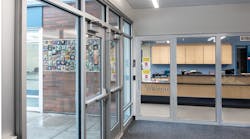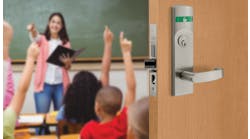The ideal door and window configuration for schools, jokes security consultant Peter Blauvelt, is "one door, no windows."
That setup might resolve many security issues and alleviate administrators' worries, but it wouldn't be a very inviting setting for educating children. So when schools look at the kinds of windows and doors they install in their buildings, they have to balance security requirements with factors such as cost, aesthetics, building and fire codes, accessibility regulations, and how windows and doors affect the overall learning environment.
Since most security threats will enter a school building through a door or a window, administrators must make sure the equipment they have in their facilities deters problems effectively.
"Years ago, it used to be vandalism and kids breaking in that you would be concerned about with doors and windows," says Blauvelt, president of the National Alliance for Safe Schools in Slanesville, W. Va. "Now, you also have to protect the building from some of the people already inside."
Window Shopping
As Blauvelt observed above, one way to eliminate security risks related to windows is to eliminate them. In the 1960s, many schools were built with limited numbers of windows to enhance security and reduce energy loss.
But more recently, educators and architects have adopted the belief, backed by some research, that regular exposure to daylight improves student performance as well as the overall climate of the school. So, newly built schools are likely to have plenty of windows.
Windows need to be sturdy enough to withstand attempts at vandalism and break-in. Some schools have used plastic instead of glass for windows, or laminated window glazing to improve security.
Window glazing that was designed to provide more energy efficiency may also have a side benefit of improving security. A window film installed over glass allows a window to absorb greater impacts, not only from vandals, but also from storms or earthquakes.
Even when some kind of impact breaks a window coated with glazing, the film often prevents the window from shattering into more dangerous shards of glass.
Buildings that require even more window security can install grates or screens over their windows to deter break-ins.
Closing the door on trouble
Institutions constructing new facilities have witnessed the violent school tragedies in the late 1990s and are incorporating more security into building design.
Stan Fredrickson, supervisor of buildings and grounds for Lakeville Area Public Schools, a quickly growing district outside Minneapolis, Minn., says he factored security concerns into the planning of Lakeville's new junior-high and elementary schools.
Schools typically want doors composed of heavy-duty material designed to withstand the abuse inflicted daily by countless students. Generally, doors in middle and high schools will require sturdier equipment than at the elementary level. But more important than what material the doors were made from was the decision of where doors would be situated in the buildings.
"The doors need to be in a well-lighted area that can be easily seen," says Fredrickson.
Blauvelt agrees that the inability to monitor a door is a greater security threat than the type of door installed.
"Too often doors end up in blind corridors, and nobody can see what's going on there," he says.
In those cases, a door could be left open, or a student or staff member responding to somebody's knock could let an intruder enter unobserved.
To prevent that from occurring, schools can install electronic systems that sound an alarm when a door is left open or opened without authorization.
Balancing safety needs
Eliminating or limiting building exits would help schools improve security. But in many cases, fire codes require many exit paths, whether through large windows or doors.
"We can't have fewer exits because of the fire codes," says Fredrickson. "We have to be able to get kids out of the building. Those doors have to stay unlocked during the day."
Doors also have to abide by accessibility guidelines such as those outlined in the Americans with Disabilities Act.
The most impenetrable doors won't provide much security if the school doesn't manage its keys and locks effectively. Keys get lost, passed around and fall into the wrong hands. Often school officials don't even know a key has been misplaced until after someone has entered their facility without authorization. Frequent rekeying of locks can be expensive and time-consuming.
Lakeville uses a high-security key system that tightly controls duplication. The keys can be copied only if Fredrickson signs a letter of authorization to a locksmith registered with the lock manufacturer.
Technology has given educators even more tools to ensure the integrity of keys and locks. Card-access systems are becoming more prevalent.
"If I were building a school," says Blauvelt, "I would install a cardless key-entry system."
Some school districts may feel such a system is more sophisticated than they need and more expensive than they can afford, but Blauvelt says the cost of access-control systems has fallen.
"They just don't keep track of who has a card, they can control the hours the cards are valid and the parts of the building someone can enter," says Blauvelt. "You can limit access to protect rooms that have student records, audiovisual equipment or computers. You can have total control."
More alternatives
To beef up security, schools might also look at installing closed-circuit cameras to monitor doors and windows where trouble occurs regularly.
Some schools limit entry to a few doors and have everyone who comes inside pass through a metal detector.
Electronic controls that are able to retract latches and lock and unlock doors from a remote location also can boost security while providing administrators greater flexibility.

